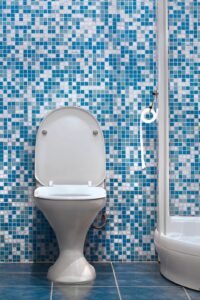Toilet Repair & Replacement
Top Signs Your Toilet Needs Repair
A toilet in need of repair can manifest several symptoms. Be on the lookout for water stains around the toilet base, constant water running, and unusual noises from the tank. These signs may indicate issues such as a worn wax ring seal, a faulty fill valve, or a damaged flapper valve. Addressing these problems early can save you from more costly repairs in the future.
Troubleshooting Common Toilet Issues
Common toilet problems can range from simple to complex. A running toilet might need a new flapper or adjustment screw tweak, while a clogged toilet might require a closet auger. Before you try to fix any toilet repairs yourself, remember that improperly attached parts or too much force can lead to bigger issues. When in doubt, contact the professionals at Atlas Home Services.
Here's a breakdown of some quick fixes you may want to consider when facing a problem with your toilet:
- Clogging: If your toilet is clogged, try using a plunger to remove the blockage. If that doesn't work, you may need to use a plumbing snake to remove the clog. Avoid flushing non-flushable items, such as baby wipes or feminine hygiene products, which can cause clogs.
- Running toilet: If your toilet runs constantly after flushing, lift up the tank lid and check the toilet flush valve in the tank to make sure it's sealing properly. If the valve is damaged or worn, it may need to be replaced.
- Leaking toilet: If you notice water around the base of your toilet, it could be a sign of a leak. Check the bolts that connect the toilet to the floor to make sure they are tight. If they are loose, try tightening them. If the leak persists, it may be a sign of a damaged wax ring, which will need to be replaced.
- Weak flush: If your toilet isn't flushing properly, try adjusting the water level in the tank or cleaning out the jets under the rim of the bowl. If neither of these steps improves the flush, the problem may be with the toilet's internal mechanisms, which may need to be repaired or replaced.
- Wobbling toilet: If your toilet wobbles or rocks, it could be a sign of a loose flange or damaged floor beneath the toilet. Check the toilet bolts and flange for tightness and stability. If the problem persists, you may need to call a professional plumber to assess and repair the issue.
Professional Toilet Repair in Pierce County, WA, and Surrounding Areas
At Atlas Home Services, we understand the inconvenience and discomfort a malfunctioning toilet can cause. That's why we are committed to providing professional toilet repair services in Pierce County, WA, and the surrounding areas. Our team of skilled plumbers is equipped to handle any toilet problem you might encounter, from a running toilet to a clogged toilet, ensuring that your plumbing system is functioning optimally.
The Benefits of Professional Toilet Repair Services
Choosing professional toilet repair services ensures that your plumbing system is handled with expertise and care. Our team not only fixes the immediate issue but also inspects your toilet and plumbing system to prevent future problems. Professional repair can also improve water pressure and water supply, contributing to a more efficient and cost-effective household.
Everything You Need to Know About Bidets
Considering an upgrade? Learn how adding a bidet can not only enhance your bathroom floor but also offer a more hygienic and eco-friendly alternative to traditional toilet paper. Our team can guide you on the various options and how they integrate with your current plumbing system. Check out these additional benefits of upgrading to a bidet:
- Enhanced cleanliness: Bidet seats offer a more thorough and hygienic cleaning experience than traditional toilet paper, which can leave residue behind. They can help reduce the risk of bacterial infections and provide a more comfortable experience.
- Environmental friendliness: Bidet seats can help reduce the amount of toilet paper used, which can help lower your carbon footprint and save money on paper products.
- Health benefits: Bidet seats can be beneficial for people with mobility issues, as they can reduce the need for bending or twisting. They can also be beneficial for people with certain medical conditions, such as hemorrhoids or urinary tract infections.
- Cost savings: Over time, bidet seats can help reduce the amount of money spent on toilet paper, as well as the potential for plumbing issues caused by excessive use of toilet paper.
Do You Need a Toilet Replacement?
Sometimes toilet repairs aren't enough, and a replacement is necessary. Our experts can help you choose and install a new toilet that suits your needs and budget. Here are some signs you may need to consider replacing your existing toilet:
- Constant clogging: If your toilet frequently clogs, even after attempts to clear the blockage, it could indicate a problem with the toilet's trap or drain. Repeated clogs can also indicate that the toilet is outdated and may not be functioning properly.
- Cracks or damage: Cracks or damage to the toilet bowl or tank can lead to leaks and water damage, which can be costly to repair. If you notice any cracks or damage, it may be time to replace the toilet.
- Persistent leaks: If you notice water around the base of your toilet or hear it constantly running, it may be a sign of a leak. Leaks can waste water and lead to water damage if left untreated. If the toilet cannot be repaired, it may need to be replaced.
- Outdated technology: Older toilets may use more water per flush than newer, water-efficient models. Upgrading to a more efficient toilet can save water and money on utility bills in the long run.
- Wobbling or rocking: A toilet that wobbles or rocks can indicate a problem with the toilet flange or the floor beneath the toilet. If the problem cannot be fixed by adjusting the toilet, it may be time to replace it to prevent further damage or safety hazards.

Trust Atlas Home Services for Fast and Reliable Toilet Repairs
$99 OFF Plumbing Service
- At Atlas Home Services, we are dedicated to providing fast and reliable toilet repair services. Our licensed plumbers are ready to tackle any toilet repair, from a water supply valve to a wax ring. We ensure a thorough job, leaving your toilet and bathroom in pristine condition. We’re proud to serve communities throughout the region, including:
- Tacoma
- Kent
- Renton
- Federal Way
- Auburn
- South Hill
- Lakewood
- Olympia
- Lacey
- Puyallup
Don't let toilet problems disrupt your day. Contact Atlas Home Services for expert toilet repair and replacement services. Our commitment to quality and customer satisfaction makes us the go-to provider in the region. Call us today for a consultation and let us bring comfort and convenience back to your home!

Common Inquires About Toilet Repair and Replacement
A well-maintained toilet can last between 15 to 30 years. However, the longevity of your toilet depends on its quality, frequency of use, and maintenance. Components like the flush valve and flapper may need replacement more frequently. Regularly checking for leaks and wear can help extend the life of your toilet.
Signs your toilet needs repair or replacement include persistent clogging, cracks in the tank or bowl, frequent repairs, a wobbly toilet base, and inefficiency in flushing. If repairs are becoming more frequent and costly, it might be more economical to opt for a new toilet.
Some minor toilet repairs like replacing the flapper valve or adjusting the fill valve can be done yourself if you have the right tools and a bit of know-how. However, for more complex issues like leaks at the toilet base or problems within the plumbing system, it's best to call in professionals like Atlas Home Services to ensure the job is done correctly and safely.
When replacing your toilet, consider efficiency, comfort, and style. Look for high-efficiency models that use less water per flush, which can save you money on water bills. Also, consider the height and shape of the toilet seat for comfort. Styles range from traditional to modern, so choose one that complements your bathroom floor and decor.
Relocating a toilet can be a complex task as it involves altering the plumbing system and water supply lines. It's typically possible but requires professional assessment and execution. Factors like the location of the main drain line and the layout of existing plumbing will affect the feasibility and cost of the move.
Yes, most modern toilets can accommodate a bidet seat attachment. You'll need to ensure your toilet has the necessary space and that there's a nearby water supply for the bidet to function. Some bidet seats require an electrical outlet as well. It's a straightforward upgrade that offers additional hygiene and comfort. If you're unsure, consult with a professional from Atlas Home Services to determine the compatibility and best options for your bathroom.

